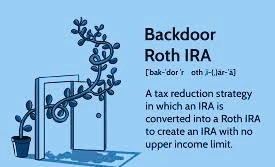Last updated Mar. 23, 2023 by Benedict Osas
There has been much debate on which is the better option; Roth IRA vs 401K. Although they both allow you to save for retirement without paying taxes, many distinctive features still make them unique.
Here’s a review on IRA and 401K to help you decide which retirement account is right for you. Let’s see.
401K vs Roth IRA: What Do They Mean?

Roth IRA
The Roth IRA is a retirement savings account that allows you to set aside a specific amount each year for your future. What sets it apart from other retirement savings options is its ability to provide tax-free growth and withdrawals once you reach retirement age.
In other words, you won’t owe any money in taxes when you withdraw money from your account after turning 59 1/2. This feature makes it an excellent choice for anyone looking to save for their golden years.
401K
On the other hand, a 401K is a retirement savings plan that an employer typically offers. With a traditional 401K, you can automatically invest a percentage of your salary into the plan.
The money you contribute is tax-deferred, meaning you won’t have to pay income taxes until you withdraw it in the future. However, when you eventually retire and start withdrawing money from your 401K savings, those withdrawals will be subject to income tax based on the prevailing tax rate.
According to The National Study of Millionaires, most millionaires built their wealth through their company’s 401K plan. So, if you’re looking to follow in their footsteps, a 401K can be a great option for you.
401(k) vs Roth IRA: Comparing Differences
When planning for retirement, many individuals choose between Roth IRAs and 401Ks, two of the most common tax-advantaged savings accounts. While both accounts offer tax-free savings growth, there are significant differences in tax treatment, investment options, and employer contributions.
#1. Purpose
When comparing 401K and Roth IRA, the main difference is that 401K is a retirement savings account created by your employer. Every month, a specific amount of money is deducted from your salary and deposited into the 401K account. On the other hand, Roth Individual Retirement Account is a retirement account you create.
#2. Tax
You will be taxed when withdrawing from a 401K account after retirement. This is because a 401K account is funded with pretax money. However, you may also be subject to taxes and penalties before retirement.
That’s because the IRS generally imposes a 10% penalty on early withdrawals from a 401K account made before the account holder reaches the age of 59 and a half.
On the other hand, a Roth IRA account is tax-free when you make withdrawals after retirement.
Still, a Roth IRA account is funded with after-tax money, meaning you pay taxes on the money before you contribute it to the account.
This can be beneficial in the long run because you won’t be taxed again when you withdraw from the account after retirement.
#3. Contribution Limit
Contribution limits are a significant consideration when it comes to retirement savings plans. For example, one of the primary benefits of a 401K plan is the possibility of employer matching contributions, which are incentivized by tax breaks. As a result, a 401K account saves $20,500 per year, while a Roth IRA saves up to $6000 per year.
For individuals turning 50 by the end of the year, the contribution limit for 2023 is $7,500. And in 2024, the limits for IRA catch-up contributions will be adjusted for inflation and subject to cost-of-living adjustments.
However, Roth IRAs have much lower contribution limits than 401Ks. For instance, the maximum contribution limit for Roth IRAs recently is $6,500, which is significantly lower than the maximum contribution limit for 401Ks.
It’s also worth noting that Roth IRAs do not allow for matching employer contributions, and they are self-funded. Shortly, employers will be required to enroll eligible employees in new 401K automatic plans with a minimum participation amount of 3% and a maximum of 10%. The contribution rate will increase at 1% each year up to a minimum of 10% and a maximum of 15%.
#4. Investment Options
For investment options, Roth IRA provides a much broader range of choices. For example, as an investor, you can shop for custodians and vehicles, offering the lowest transaction and administrative expenses.
Roth IRA allows you to decide on what to invest your funds into. This allows you to make the most out of your investment and potentially earn more money in the long run.
In contrast, with a 401K, your investment options are limited to those the plan administrator offers. This means that your employer decides on your behalf. Typically, these options include various types of mutual funds with predetermined expense ratios.
While this may be convenient for some investors, it can be limiting for those who are looking for more control over their investments.
#5. Required Minimum Distribution (RMD)
RMD is a policy that mandates you to withdraw money from a retirement savings account when you reach a certain age. For example, a 401K account will require you to withdraw money from your account when you are past the age of 72. However, that has been increased to 73 for some individuals under the SECURE Act 2.0.
Roth IRA, on the other hand, does not require you to withdraw money or take Required Minimum Distributions (RMDs) once you reach a certain age. Therefore, you can decide to save your money forever in a Roth IRA account. This provides flexibility and allows you to continue contributing to your account.
It also allows your funds to grow for as long as you want. If you pass away, your Roth IRA can be passed on to your spouse or descendants.
Failure to meet your RMD requirements can result in financial penalties. However, if you correct your mistake quickly, they’ll reduce the penalty.
It’s also worth noting that the SECURE Act 2.0 has eliminated the pre-death RMD requirement for Roth-designated accounts in employer 401Ks or other retirement plans beginning in 2024. This provides additional flexibility and tax benefits for those who invest in a Roth IRA.
#6. Income Limits
Another important consideration when choosing between a Roth IRA and a Roth 401K is income limits. Roth IRAs have income limits that restrict eligibility for contributions.
For example, in 2022, individual taxpayers with an AGI of over $144,000 or married couples filing jointly who made over $200,000 are not eligible for Roth IRA contributions. However, in 2023, the eligibility thresholds have increased, allowing individuals making up to $153,000 and couples making up to $228,000 to contribute.
On the other hand, one significant advantage of a 401K is the absence of an income limit. This means that even high-income people can still contribute to the account. So, you don’t need to worry about how much you should have in your 401K.
401(k)s have higher contribution limits than Roth IRAs, saving you more money toward your retirement goals.
#7. Loans
One advantage of a 401K is the ability to borrow up to 50% of your account balance or $50,000, whichever is smaller. However, if you fail to repay the loan per the agreement’s terms, that money may be subject to taxes.
On the other hand, Roth IRAs do not allow loans but permit Roth IRA rollovers. You have 60 days to move your money from one account to another during the rollover period.
If you return the money to the original account or another Roth IRA within the specified time frame, you effectively receive a 0% interest loan for 60 days.
#8. Eligibility
To be eligible for a Roth IRA, you must have earned income and meet certain income restrictions based on your filing status. This type of IRA is typically only available through employer-sponsored programs, and there may be a waiting period before you can enroll.
Lastly, married couples with only one income earner can also open a spousal Roth IRA. That provides a valuable opportunity for those who may not have access to employer-sponsored programs.
By carefully considering your unique financial situation and goals, you can determine whether a Roth IRA is the right investment choice for you.
Which is Better? To Invest in Roth IRA or 401K.
Roth IRA and 401K are great retirement savings accounts to consider. However, if you want to decide which account to invest in, many factors must be considered.
- If your workplace offers a matching program for 401K, you should invest in a 401K account.
- Choose a Roth IRA account if you want total control over your investment and costs.
- If you want an account with a higher contribution limit, choose 401K.
- Invest in Roth IRA if your company does not offer a matching program.
- Choose a Roth IRA account if you want to access your money before retirement.
Nevertheless, both Roth IRA and 401K are great ways to save for retirement. None is better than the other. Making a decision depends on your personal preference.
When a Roth May Be Right for You
If you find yourself in one of these situations, a Roth IRA may be a smart investment choice for you.
Firstly, if you are currently in a lower tax bracket but anticipate being in a higher one in the future, contributing to a Roth IRA means you’ll pay a relatively low rate on taxable income now and won’t have to pay any taxes on qualified distributions from the plan in retirement.
Secondly, a Roth contribution may be preferable if you are close to retirement and are worried about required minimum distributions (RMDs) bumping you into a higher tax bracket. RMDs are required withdrawals from Traditional IRAs and 401Ks, including Roth 401Ks, beginning in the year you turn 72.
Qualified distributions from a Roth 401K or Roth IRA would not create taxable income or increase your tax rate. That makes it a smart way to limit the RMD income taxed at a higher rate.
You can save money and consider contributing the maximum amount to a retirement plan. If you choose to contribute to a Roth account, you can effectively save more in a tax-advantaged way, even without getting a tax break. By saving the maximum amount in a Roth account, you can ultimately end up with more after-tax retirement assets than with a traditional contribution that is pretax.
When 401K might be good for you
However, there are situations where a traditional 401K may be a better choice than a Roth option. Here goes.
For example, if you are in your peak earning years and expect your income to drop significantly in retirement, funding your traditional 401K may be more beneficial. This is because you get a tax deduction right now when it benefits you the most. Then, when you retire and are in a lower tax bracket, you will owe less to the IRS on your withdrawals.
Another scenario in which a traditional 401K may be preferred is if you must withdraw within five years of opening your 401K. Unlike a Roth IRA, a Roth 401K is less flexible regarding the timing of withdrawals.
You can begin making penalty-free withdrawals from a traditional 401K at age 59 ½, while with a Roth 401K, you’ll need to wait at least five years from opening your account, regardless of your age, to avoid taxes and penalties on earnings.
If you’re getting a late start on retirement savings or working for a new employer near age 59½, you may want to stick with a traditional 401K to avoid this 5-year rule.
Another potential advantage of a 401K plan is converting it into a Roth 401K account. This benefit is not available to Roth 401K contributions, which cannot be converted back into a pretax traditional 401K account after five years.
However, with a 401K plan, you can convert it into a Roth 401K at any time in the future, as long as you can pay the taxes due at that time. This flexibility can be useful if your tax situation changes or if you want to wait until a lower-income year to pay the taxes on your contributions.
Can You Have a 401K and a Roth IRA?
Yes! You can have a 401K and a Roth IRA retirement savings account simultaneously. Saving money for retirement in multiple retirement accounts is a good strategy to benefit your future.
If you are eligible for both accounts, it is recommended that you create both of them to secure a stable retirement life. The more you contribute to retirement accounts, the better your life will become.
The maximum contribution for a 401K account is $20,500 per year in 2022. However, if you are above 50, you will become eligible to contribute $27,000 per year.
A Roth IRA has a maximum contribution of $6000 annually in 2022. But if you are 50 or older, you can save $7000 per year. Many financial and retirement planning experts recommend the idea of having a Roth IRA and 401K account at the same time.
What is the Downside of a Roth IRA?
Although Roth IRA has many pecks and advantages, there are still some downsides to it. Here are some reasons why a Roth IRA account may not be the best for you.
- Non-Tax Deductibles
Before contributing to a Roth IRA account, you must pay taxes on your income. Therefore, Roth IRA can only be funded with after-tax dollars.
- Limited Contribution
Unlike a 401K account, which allows you to contribute at most $27,000 annually, Roth IRA only enables you to contribute $6000 annually.
- Inflexibility
A traditional IRA and other types of IRA accounts allow you to make transfers from one to another. However, Roth IRA doesn’t allow for the transfer of funds to other IRA accounts.
What is a Backdoor Roth IRA?

A backdoor Roth IRA is essentially a strategy for high-income earners to contribute to a Roth IRA despite the income limitations that come with it. Essentially, it’s not a separate type of Roth IRA account but rather a term used to describe a workaround.
It’s essential for those who would otherwise be unable to directly contribute to or open a Roth IRA due to income restrictions. Since Roth IRAs have income limits, individuals who exceed them can use a “backdoor” method.
That involves investing in a traditional IRA with no income restrictions and then converting that account to a Roth IRA. While this approach may sound underhanded, it’s entirely legal. IRA. The only difference is that you will have to pay taxes on the converted funds upfront, but then your money can grow tax-free in the Roth IRA.
Is It Good to Max Out 401K?
The Internal Revenue Service (IRS) has an annual contribution limit for a 401K account. For 2022, you are expected to contribute not more than $20,500 per year or $27,000 if you’re above the age of 50.
Many workers need help to Max out their 401K contribution limit. If you can contribute $20,500 before the end of the year, it will benefit you in your retirement age.
Aside from having more money for retirement, there are no other benefits of maxing out your 401K account.
Comparing Roth 401K vs Standard/ Traditional 401K
Roth 401K is an employer-sponsored retirement savings account that enables you to make a tax-free withdrawal after retirement. Before funding this account, your employer will deduct tax from the amount meant for savings. Hence, no taxes will be placed on you when you withdraw after retirement.
The Traditional 401K account is pretax-funded. Hence taxes will be placed on your account when you withdraw after retirement.
Roth 401K and the traditional 401K are similar. The only feature that makes them different is the withdrawal process. After retirement, any withdrawals from a standard 401K account will be taxed. However, the Roth 401K account is tax-free after your retirement. You should check out some of the best solo 401K options out there.
With a 401K calculator, you can estimate which is better between Roth and a Traditional 401K calculator. This calculator lets you determine how much you can save using Roth 401K or Traditional (k). There are some online you can try out.
Comparing Roth IRA vs. Traditional IRA
Roth IRA and a Traditional IRA have various similarities. They are suitable for individuals without employer-sponsored retirement savings accounts like 401K. Both have the same savings plans and annual contribution limits.
In addition, both Roth IRA and traditional IRAs require you to hit the age of 59½ before making withdrawals. They also don’t come with a Required Minimum Distribution (RMD).
The key difference between traditional and Roth IRAs is the withdrawal policy. Since a Traditional IRA account allows you to contribute a part of your pretax income, you will be taxed when making withdrawals during retirement.
A Roth IRA allows you to contribute a portion of your post-tax income; hence, you won’t be taxed when making withdrawals during retirement.
Alternatives To 401K You Can Try Out As Investment Options

A 401K account is great. However, there are other better investments for retirement. Here are some retirement savings plans that are better than a 401K option:
- Traditional IRA
This retirement savings account allows you to put away pretax dollars. However, the tax will be imposed on you when you make withdrawals during your retirement.
- Roth IRA
This account is funded with after-tax dollars. Hence, it is non-tax deductible even after retirement.
- Serp IRA
If you own a business, this retirement savings account is a better investment option than 401K. This account allows you to contribute up to $61,000 annually in 2022.
- Health Savings Account (HSA)
As the name suggests, this is a retirement saving account for people with health issues. In addition, this account enables you to pay for your spouse’s medical emergencies even if they are not under your health plan. It’s one of the best places to keep an emergency fund.
Final Opinion
Looking even further ahead to retirement planning, inheriting money from a Roth account can benefit your family members. As long as the Roth 401K has existed for at least five years, your heirs will not have to pay income taxes on the distributions from an inherited Roth.
It’s wonderful that you’ve got a choice—and your ideal choice may be to invest in both accounts. So, whichever you choose is already preparing for and planning for retirement. And that is pretty much the smartest choice of all.
Frequently Asked Questions On Roth IRA Vs. 401K
How do I choose between Roth and 401K?
Having the option to choose between a traditional and Roth 401K is a great advantage. The best choice for you will depend on your current tax situation and your anticipated situation in retirement.
If you expect your retirement tax rate to decrease, traditional deferrals may be the better option. On the other hand, if you anticipate your tax rate to increase in retirement, then Roth deferrals may be the better choice.
Should I have a 401K and a Roth IRA?
Investing in both types of accounts may also be a good option. But ultimately, the most important decision is to start planning and saving for retirement as early as possible.
Use all the savings and investing vehicles available to you, including a 401K and IRA, to save as much as possible and get the full tax break. You won’t regret it.
At what age does a Roth IRA not make sense?
No matter your age, it’s never too late to start funding a Roth IRA. Even if you open a Roth IRA later in life, you won’t have to worry about the early withdrawal penalty on earnings if you’re at least 59 ½ years old.
However, it’s important to note that regardless of when you open a Roth IRA, you must wait at least five years to withdraw the earnings tax-free.
Is 40 too old to start a Roth IRA?
No! The age of 40 is pretty young to start a Roth IRA account. There are no age restrictions when creating a retirement savings account.
Should I split my 401K between Roth and traditional?
Yes, you should. Splitting your 401K between Roth and traditional may be a good idea due to future tax rates’ unpredictable nature.
Is a Roth IRA really worth it?
Yes! A Roth IRA is worth it. It enables you to save money without worrying about future tax rates.
Why do people prefer Roth IRA?
One of the main reasons people prefer Roth IRAs is the tax benefits they offer. Unlike traditional IRAs, funded with pretax money, Roth IRAs are funded with after-tax money. This means that earnings in the account grow tax-free, and withdrawals in retirement are also tax-free.
Should I do 401K or Roth 401K high income?
While traditional 401K contributions offer an up-front tax break, high earners may want to consider a Roth 401K if they expect to be in a higher tax bracket in retirement.
On the other hand, if you anticipate being in a lower tax bracket in retirement, a regular 401K contribution may make more sense for you. It’s important to consider your tax situation carefully and choose the choice that will benefit you most in the long run.
How much money should I contribute to my Roth IRA each month?
It’s recommended that you follow a dollar-cost-averaging approach and contribute $500 per month if you’re under 50 years old, which is the maximum annual contribution limit of $6,000. If you’re over 50, the maximum annual contribution limit is $7,000, so you should contribute $583 monthly.
What is the highest-paying IRA?
If you’re wondering which IRA pays the highest return, Bankrate’s top picks for the best IRA CD rates include Bethpage Federal Credit Union, Citibank, and America First Credit Union. These institutions offer APYs ranging from 0.05% to 5.00%, depending on the length of the investment term and minimum deposit requirements.
What is the safest IRA investment?
If you’re seeking a safe IRA investment, Treasury bonds are a good option. They’re backed by the full faith and credit of the US government, making them one of the safest investment choices available.
What is the best IRA for a 25-year-old?
For a 25-year-old investor, Roth contributions are generally more advantageous than traditional contributions. This is because tax-free distributions in retirement can be a significant benefit, especially if taxes increase in the future. Additionally, younger investors can benefit even more from compounding growth due to their longer investment time horizon.
Do the rich have an IRA?
Although many people may associate IRAs with middle-class savers, ultra-wealthy Americans have reportedly built tax-sheltered accounts worth millions or even billions of dollars. That’s thanks to the introduction of the Roth IRA and relaxed IRA rollover restrictions in recent decades.







